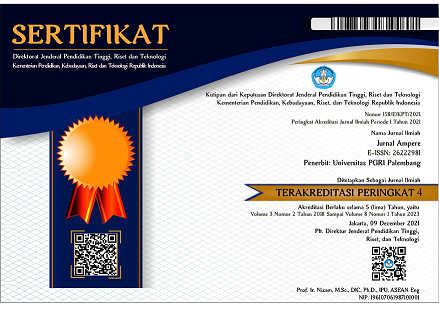PENGAPLIKASIAN SENSOR WARNA PADA NAVIGASI LINE TRACKING ROBOT SAMPAH BERBASIS MIKROKONTROLER
DOI:
https://doi.org/10.31851/ampere.v4i2.3450Abstract
Static garbage boxes, which cannot move to the location where people want to dispose the garbage, is one of the reasons why people tend to litter. This static garbage box tends not to save energy and time of people who will dispose the garbage. In this research, a concept of handling waste using garbage robots is offered. This garbage robot is designed to move towards the location of people who want to dispose of trash. This robot can run automatically. Another advantage of using this garbage robot is the navigation of the robot that uses line tracking so that the robot's way to the garbage location can be arranged. Garbage locations are distinguished by color, while robot motion systems are based on line sensors as line track detectors. Using the robot that can go to the location, people who will dispose of the garbage can save more energy and time
Abstrak Kotak sampah statis, yang belum bisa bergerak menuju tempat orang yang ingin membuang ‎sampah, merupakan salah satu sebab orang cenderung membuang sampah ‎sembarangan. Hal ini diakrenakan kotak sampah statis tidak menghemat ‎energi dan waktu orang yang akan membuang sampah. Pada penelitian ini, ditawarkan sebuah konsep penanggulangan sampah ‎menggunakan robot sampah. Robot sampah ini dirancang dapat bergerak menuju lokasi ‎orang yang ingin membuang sampah. Robot ini dapat berjalan secara otomatis. ‎Keuntungan lain dari penggunaan robot sampah ini adalah navigasi yang ‎menggunakan line tracking sehingga jalannya robot menuju ‎lokasi sampah dapat tertata. Lokasi sampah dibedakan berdasarkan warna, sedangkan sistem gerak robot berbasis sensor garis sebagai pendeteksi line track. Dengan adanya robot sampah yang bisa menuju lokasi, orang yang akan membuang sampah dapat lebih menghemat ‎energi dan waktu. ‎
Â
Kata kunci : Robot sampah, Sensor warna, Line Tracking
Â
References
Suhendra MA.2017.Rancang Bangun Sistem Kotak Sampah Berhadiah Menggunakan Arduino Uno dengan Output Suara dan Cokelat Butir sebagai Hadiah Secara Otomatis. Politeknik Negeri Sriwijaya.
Tomy.2016.Aplikasi Sensor Warna TCS3200 dan Ultrasonic Ping))) Paralax pada Robot Pencari dan Pengantar Target berbasis Mikrokontroler ATMEGA 32. Politeknik Negeri Sriwijaya.
Ardianto A, Studi P, Elektronika T, Teknik F, Yogyakarta UN.2017.Sistem Tekanan Mekanik Berbasis Mikrokontroler AT-Mega 16 Untuk Pembuat Kerupuk Pelompong Guna Menunjang Produksi Home Industry Barokah di Tuban Jawa Timur.
Robotdyn. Robotdyn Mega + WiFi R3 ATmega2560 + ESP8266 n.d.
TAOS. Programmable Color Light-To-Frequency Converter Texas Advanced Optoelectronic Solutions Inc. Programmable 2011:1–14.
[] Infineon Technologies 2004.High Current PN Half Bridge BTS 7960.
Ksatriaunisi.2013.scanning menggunakan TCS3200 dan ‎arduino uno. https://ksatriaunisi.wordpress.com/2013/08/04/rgb-scanning-menggunakan-tcs-3200-dan-‎arduino-uno/‎ (accessed May 22, 2019).
Jogjarobotika.2017.Gy-31 TCS3200 Color sensor module. http://www.jogjarobotika.com/sensor-warna/1317-gy-31-tcs3200-color-sensor-module.html (accessed April 3, 2019).
Downloads
Published
How to Cite
Issue
Section
License

Jurnal Ampere is licensed under a Creative Commons Attribution-ShareAlike 4.0 International License.
Authors who publish with this journal agree to the following terms:
- Authors retain copyright and grant the journal right of first publication with the work simultaneously licensed under a Creative Commons Attribution License that allows others to share the work with an acknowledgement of the work's authorship and initial publication in this journal.
- Authors are able to enter into separate, additional contractual arrangements for the non-exclusive distribution of the journal's published version of the work (e.g., post it to an institutional repository or publish it in a book), with an acknowledgement of its initial publication in this journal.
- Authors are permitted and encouraged to post their work online (e.g., in institutional repositories or on their website) prior to and during the submission process, as it can lead to productive exchanges, as well as earlier and greater citation of published work.






